5.2 Levels of Organization and Body Systems
The first four chapters of this text have provided you with a solid foundation about medical terminology and its components. This chapter will allow you to apply that knowledge to basic concepts about anatomy, physiology, and other aspects of the human body. Anatomy focuses on structure, whereas physiology focuses on function. The video below will give you an overview of what anatomy and physiology encompass, then the remaining part of this section will discuss them in more detail.
(CrashCourse, 2015)
The Levels of Organization
As shown in Fig. 5.1, it is best to consider the structures of the body in terms of levels of organization that increase in complexity: atoms, molecules, cells, tissues, organs, organ systems (body systems), and organisms.
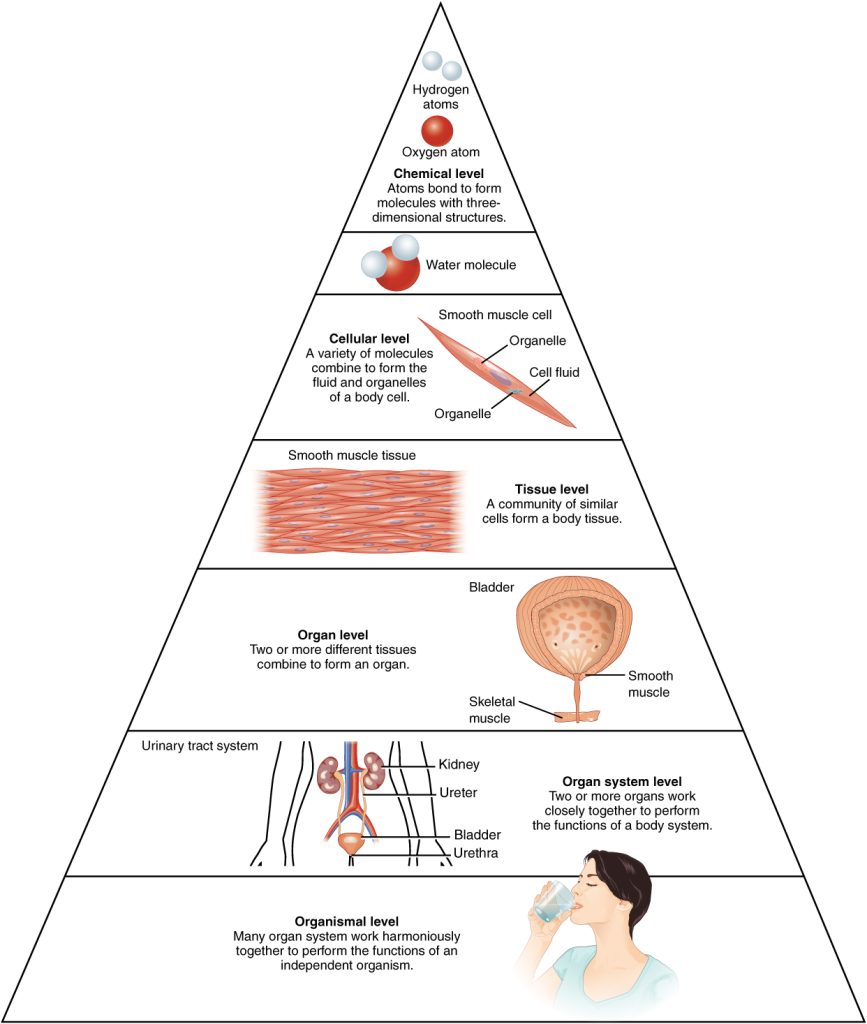
All matter in the universe is composed of one or more unique pure substances called elements. Some examples of theses are hydrogen, oxygen, carbon, nitrogen, calcium, and iron. The smallest unit of any of these elements is the atom, and two or more atoms combine to form a molecule. Examples of molecules include water, proteins, and sugars that are found in all living things. Molecules are essentially the building blocks of all body structures.
A cell is the smallest independently functioning unit of a living organism. All aspects of human anatomy contain cells, and all the functions of human physiology are performed in cells or are initiated by cells.
A tissue is a group of many similar cells that work together to perform a specific function, and an organ is a distinct structure of the body composed of two or more tissue types. Each organ performs one or more specific physiological functions. There are many organs in the human body, and you learned about those organs in the first few chapters of this book in reference to the combining forms used in medical terminology. An organ system (body system) is a group of organs that work together to perform major functions and meet the physiological needs of the body.
There are 11 body systems. You will learn more about these body systems in Chapter 6, but a brief overview of them is given below. It is important to note that many organs actually work in more than one body system.
Key Concept
In the human body, the organs work collaboratively with multiple body systems. For example, the heart (cardiovascular system) and lungs (respiratory system) work together to deliver oxygen throughout the body and remove carbon dioxide from the body.
The organism level is the highest level of organization, and an organism can independently perform all the physiologic functions necessary for life. In a multicellular organism such as a human, all the cells, tissues, organs, and organ systems work together to maintain life.
Body Systems Overview
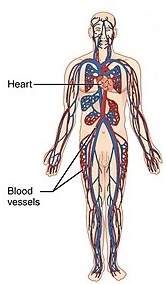
Cardiovascular System
- This system uses blood to deliver nutrients throughout the body and remove wastes from the body.
- The heart, which is the primary organ in this system, pumps blood around the body via a network of blood vessels.
- Blood, blood vessels, and the heart make up this complex system.
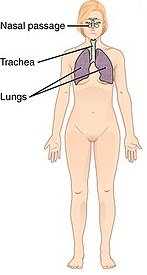
Respiratory System
- The primary functions of the respiratory system are to provide oxygen to the body’s tissues for cellular respiration, remove the waste product carbon dioxide from the body, and help maintain the acid-base balance.
- The nose, trachea, lungs, bronchi, and bronchioles are the major parts in this system.

Endocrine System
- The purpose of the endocrine system is to regulate various organs by releasing hormones (chemical messengers).
- The pituitary, thyroid, parathyroid, and adrenal glands make up this system, along with the pancreas, testes, and ovaries.

Female Reproductive System
- This system functions to produce gametes and reproductive hormones.
- Its other function is to support a developing fetus and deliver it to the outside world.
- The ovaries, uterus, fallopian tubes, and mammary glands make up this system.
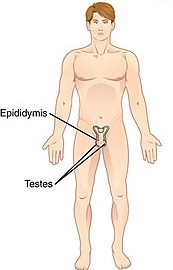
Male Reproductive System
- The function of the male reproductive system is to produce sperm.
- The testes, scrotum, epididymis, vas deferens, prostate, seminal vesicles, and penis make up this system.
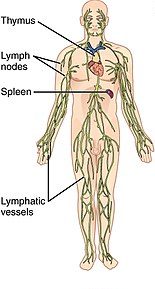
Lymphatic System
- The major function of the lymphatic system is to drain extra body fluid (lymph) and return it to the bloodstream.
- It is also associated with the immune system and plays an important role in immunity.
- This system consists of a network of lymphatic vessels, as well as the spleen and lymph nodes and ducts.
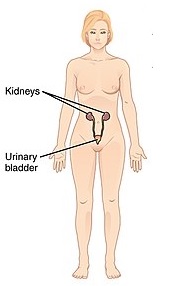
Urinary System
- This system has various functions, but its main responsibility is cleansing the blood and removing wastes from the body.
- It also stores urine until a convenient time for disposal and provides the structures for transporting liquid waste from the body.
- This system consists of the kidneys, ureters, urethra, and bladder.
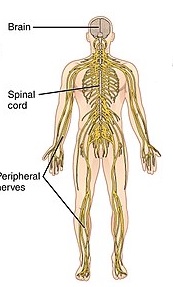
Nervous System
- This system is very complex and is responsible for controlling much of the body, including both voluntary and involuntary functions.
- It is responsible for taking sensory input and integrating it with other sensations, memories, emotional states, and learning.
- The nervous system can be divided into two main components: the central nervous system and the peripheral nervous system.
- It consists of the brain, spinal cord, and nerves.
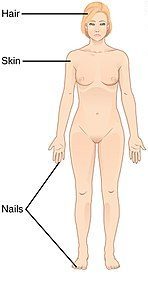
Integumentary System
- This system is one of the largest body systems and makes up approximately 16% of total body weight.
- The main component of this system is the skin.
- The skin protects the inner organs, controls thermoregulation, functions as a sensory organ, and is necessary for vitamin D synthesis.
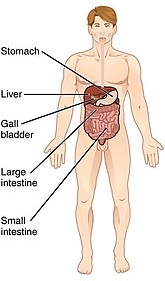
Digestive System
- The function of the digestive system is to break down food, release its nutrients, absorb those nutrients into the body, and excrete waste.
- This system consists of the stomach, liver, gallbladder, and small and large intestines.
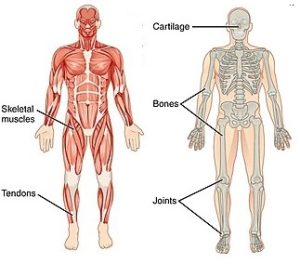
Musculoskeletal System
- The function of this system is to support the body, facilitate movement, and protect the internal organs.
- Bones are also vital in the production of red blood cells.
- The musculoskeletal system consists of all the bones, muscles, joints, tendons, and cartilage in the body.
Table. 5.1. Combining Form Review
| COMBINING FORM | MEANING |
| bronch/o | bronchial tubes |
| cardi/o | heart |
| chondr/o | cartilage |
| col/o | colon |
| dermat/o | skin |
| encephal/o | brain |
| epitheli/o | skin |
| gastr/o | stomach |
| hepat/o | liver |
| lymph/o | lymph |
| nephr/o | kidney |
| neur/o | nerve |
| optic/o | eye |
| pulmon/o | lung |
| ur/o | urinary tract, urine, urea |
| vascul/o | blood vessels |
(Carter & Rutherford, 2020)
Exercises
Attribution
Unless otherwise indicated, material on this page has been adapted from the following resource:
Betts, J. G., Young, K. A., Wise, J. A., Johnson, E., Poe, B., Kruse, D. H., Korol, O., Johnson, J. E., Womble, M., & DeSaix, P. (2013). Anatomy and physiology. OpenStax. https://openstax.org/details/books/anatomy-and-physiology licensed under CC BY 4.0
References
Carter, K., & Rutherford, M. (2020). Building a medical terminology foundation. eCampusOntario. https://ecampusontario.pressbooks.pub/medicalterminology/ licensed under CC BY 4.0
CrashCourse. (2015, January 6). Introduction to anatomy & physiology: Crash Course anatomy & physiology #1 [Video]. YouTube. https://www.youtube.com/watch?v=uBGl2BujkPQ&t=11s
101 Levels of Org in Body by OpenStax, CC BY 3.0
Organ Systems I by OpenStax, CC BY 3.0 (circulatory system)
Organ Systems II by OpenStax, CC BY 3.0 (respiratory system)
Organ Systems I by OpenStax, CC BY 3.0 (endocrine system)
Organ Systems II by OpenStax, CC BY 3.0 (female reproductive system)
Organ Systems II by OpenStax, CC BY 3.0 (male reproductive system)
Organ Systems II by OpenStax, CC BY 3.0 (lymphatic system)
Organ Systems II by OpenStax, CC BY 3.0 (female urinary system)
Organ Systems II by OpenStax, CC BY 3.0 (nervous system)
Organ Systems I by OpenStax, CC BY 3.0 (integumentary system)
Organ Systems II by OpenStax, CC BY 3.0 (digestive system)
Organ Systems II by OpenStax, CC BY 3.0 (musculoskeletal system)

